These Five Countries Account for 60 Percent of Plastic Pollution in Oceans
ENVIRONMENT, 9 Nov 2015
Lorraine Chow, EcoWatch – TRANSCEND Media Service
Roughly 8 million tons of plastic is dumped into the world’s oceans every year, and according to a new study, the majority of this waste comes from just five countries: China, Indonesia, the Philippines, Thailand and Vietnam.
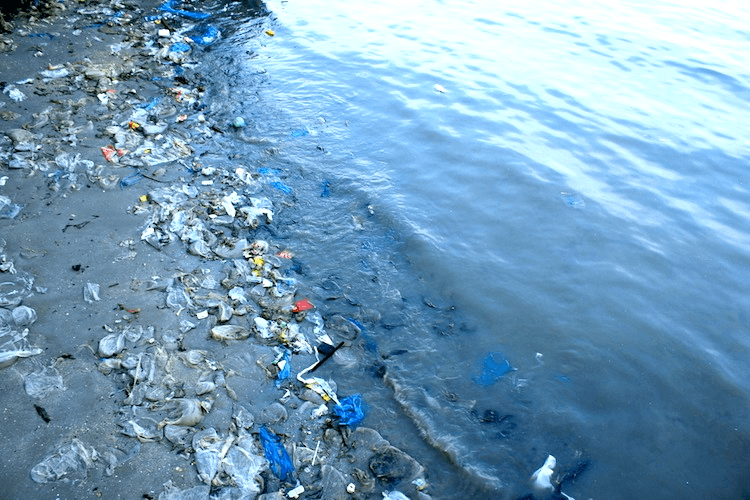
Plastic waste and other garbage on Rayong beach, Thailand. Photo credit: relax_gap / Shutterstock.com
It appears that these five countries are responsible for up to 60 percent of the marine plastic entering our oceans, according to Stemming the Tide, a study released last month by the Ocean Conservancy and McKinsey Center for Business and Environment.
Why are these parts of Asia leaking so much plastic? Well, as the study suggests, these emerging countries are experiencing rapid economic growth, reduced poverty and improved quality of life. This development is, of course, fantastic. However, as these economies grow, so does the consumer use of plastic and plastic-intensive goods.
The caveat of this increased plastic demand is that these countries do not yet have waste-management infrastructures that can tackle the accompanying excess waste.
It’s projected that by 2025, plastic consumption in Asia will increase by an astonishing 80 percent to surpass 200 million tons. And unless steps are taken to manage this waste properly, in ten short years the ocean could contain one ton of plastic for every three tons of fish, “an unthinkable outcome,” the study says.
It makes sense then, as Fast Company observed from the study, that global ocean plastic clean-up efforts should initially be concentrated in these areas.
“Specifically, interventions in these five countries could reduce global plastic-waste leakage by approximately 45 percent over the next ten years,” the report says.
The study’s authors came up with the five best approaches (out of 21) to address plastic waste, customized for each country: collection services, closing leakage points in collection facilities, gasification (converting waste into fuel) and MRF-recylcing (diverting plastic from the waste stream).
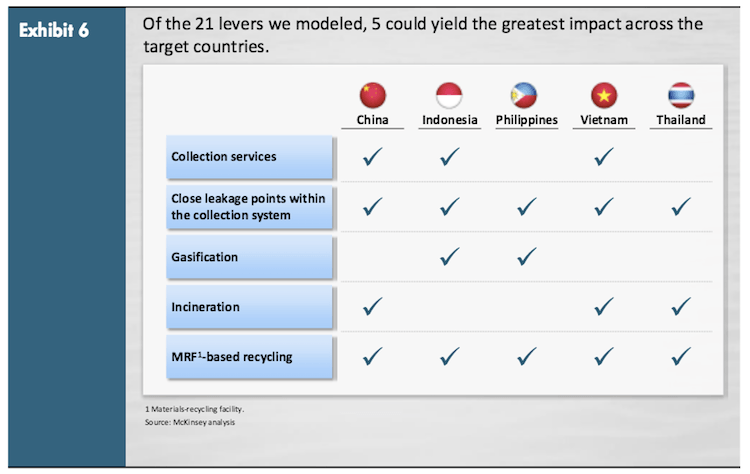
“Coordinated action in just these five countries could significantly reduce the global leakage of plastic waste into the ocean by 2025,” the report says. Photo credit: Ocean Conservancy and McKinsey Center for Business and Environment
“This study outlines a path that can generate considerable benefits to communities, preserve the bio-productivity of the ocean, and reduce risks for industry,” the report says. “Concerted action in the form of a $5 billion annual ramp-up in waste-management spending could create a vibrant secondary resource market, trigger investment in packaging and recovery systems, and let the ocean thrive.”
“Of course, extending these interventions to other countries could have even more impact on this global issue,” the report points out.
Plastic waste in the Philippines, for instance, is having “drastic consequences on the livelihoods and health of the people of Dagupan,” said city mayor Belen Fernandez in a press release for the study.
New Ocean Conservancy Report Finds Plastics in Ocean at Crisis Level http://t.co/SDXAJFN3wZ via @fortunemagazine
— Defenders of Wildlife (@Defenders) October 14, 2015
“Our town has had a dump site on our beach for over 50 years,” he continued about the coastal Philippine city. “We’re working hard to close the dump, and increase the capacity of waste management in Dagupan. Addressing the problem of ocean plastic will have real benefits for not just the environment, but for our citizens—by improving their quality of life. I hope our city and our work will become a model for what’s possible around the world.”
Andreas Merkl, CEO of Ocean Conservancy, said in a statement that the study is the first to outline a specific path forward for the reduction and ultimate elimination of plastic waste in the oceans.
“The report’s findings confirm what many have long thought—that ocean plastic solutions actually begin on land. It will take a coordinated effort of industry, NGOs and government to solve this growing economic and environmental problem,” he said.
Check out some of the Ocean Conservancy’s infographics on the issue below:
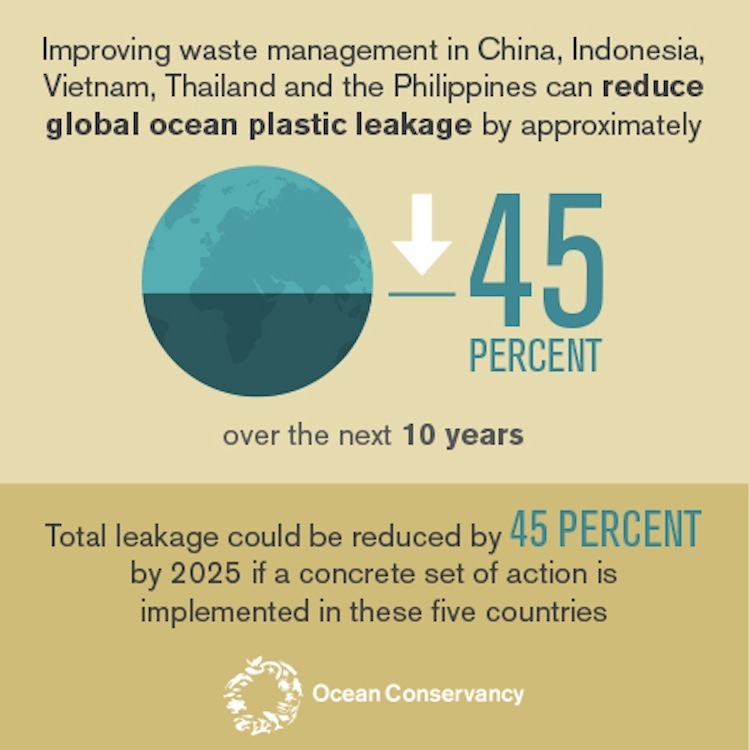
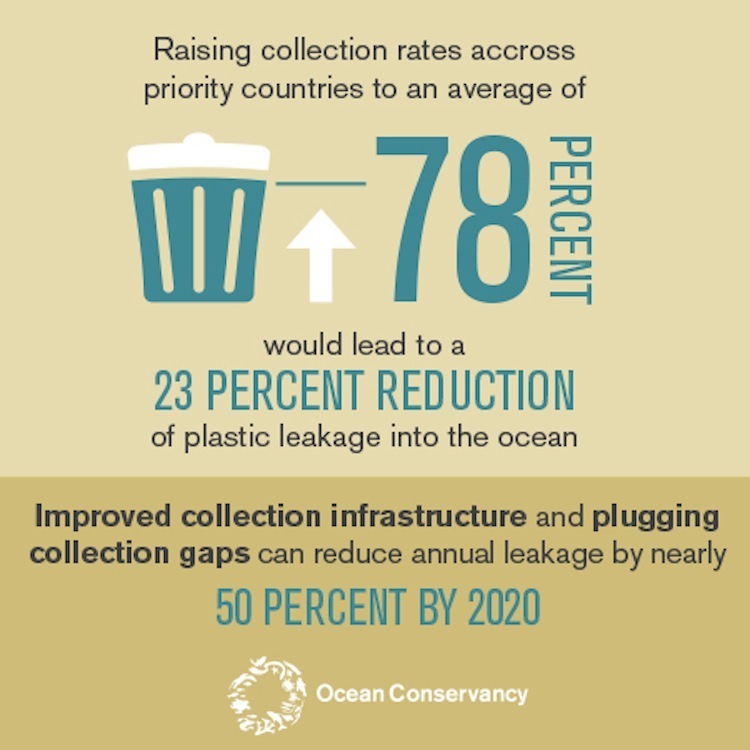
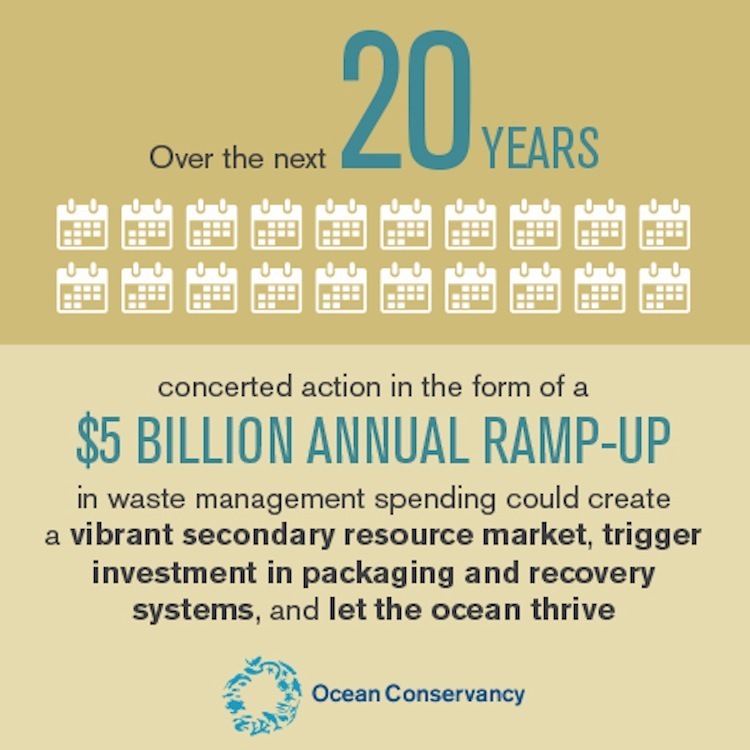 ________________________________
________________________________
YOU MIGHT ALSO LIKE:
Interactive Map Shows 414 U.S. Cities Already Locked Into Catastrophic Sea Level Rise
Nestlé: Unbottle California’s Water
Disturbing Images Expose the Horrific Impact of Plastic Trash on Marine Animals
22 Facts About Plastic Pollution (And 10 Things We Can Do About It)
DISCLAIMER: The statements, views and opinions expressed in pieces republished here are solely those of the authors and do not necessarily represent those of TMS. In accordance with title 17 U.S.C. section 107, this material is distributed without profit to those who have expressed a prior interest in receiving the included information for research and educational purposes. TMS has no affiliation whatsoever with the originator of this article nor is TMS endorsed or sponsored by the originator. “GO TO ORIGINAL” links are provided as a convenience to our readers and allow for verification of authenticity. However, as originating pages are often updated by their originating host sites, the versions posted may not match the versions our readers view when clicking the “GO TO ORIGINAL” links. This site contains copyrighted material the use of which has not always been specifically authorized by the copyright owner. We are making such material available in our efforts to advance understanding of environmental, political, human rights, economic, democracy, scientific, and social justice issues, etc. We believe this constitutes a ‘fair use’ of any such copyrighted material as provided for in section 107 of the US Copyright Law. In accordance with Title 17 U.S.C. Section 107, the material on this site is distributed without profit to those who have expressed a prior interest in receiving the included information for research and educational purposes. For more information go to: http://www.law.cornell.edu/uscode/17/107.shtml. If you wish to use copyrighted material from this site for purposes of your own that go beyond ‘fair use’, you must obtain permission from the copyright owner.